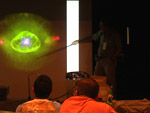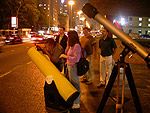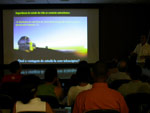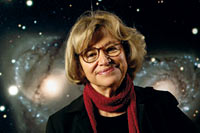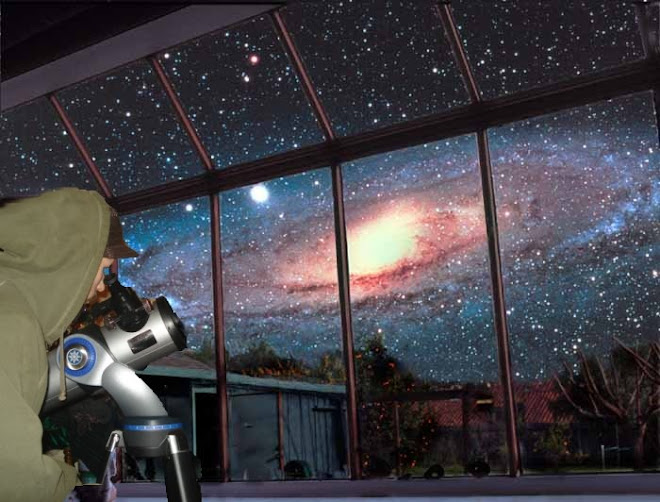for those who dont have a telescope...
IYA is doing this... :)
IYA2009 Telescope News Release - IYA0906: Galileoscope in production: The IYA2009 telescope is now available!
Mar 4, 2009, Paris
The Galileoscope — a high quality, easy-to-assemble and easy-to-use telescope at an unprecedentedly low price — is now available to order. A Cornerstone project of the International Year of Astronomy 2009 (IYA2009), the Galileoscope was developed by a team of leading astronomers, optical engineers and science educators to make the wonders of the night sky more accessible to everyone. Orders can now be placed through www.galileoscope.org for delivery beginning in late April.
By encouraging the experience of personally seeing celestial objects, the Galileoscope project aims to facilitate a main goal of IYA2009: promoting widespread access to new knowledge and observing opportunities. Observing through a telescope for the first time is an experience that shapes our view of the sky and the Universe. It prompts people to think about the importance of astronomy, and for many it's a life-changing experience. Galileoscopes will open up a whole new world for their users and are an excellent means of pursuing an interest in astronomy during IYA2009 and beyond.
Galileoscopes are available at the incredibly low price of US$15 per kit. Discounts are available for group purchases of 100 or more, bringing the price down even lower, to US$12.50 each, reducing costs for schools, colleges, astronomical societies, or even parties of interested individuals. Never before has such a high quality and professionally endorsed scientific instrument been available for this price.
To further this aim, the Galileoscope Cornerstone project has initiated the "Give a Galileoscope" programme. Participants may buy Galileoscopes for themselves, their families, or their friends at the regular $15 or $12.50 price (depending on quantity) plus shipping, and/or donate as many telescopes as they'd like for $12.50 each, with no shipping charges. Donated Galileoscopes will go to less advantaged schools and other organisations worldwide, especially in developing countries. This will help bring a modern education to students in poor schools and empower them to pursue science and technology knowledge. Donating Galileoscopes increases the project's global impact and gives people who might otherwise never have the opportunity to look through a telescope the chance to join millions of skywatchers worldwide in a shared experience of astronomical discovery.
The Galileoscope is named after the Italian astronomer Galileo Galilei, who first observed the heavens through a telescope 400 years ago. His observations were nothing short of revolutionary and changed our view of the world forever. The Galileoscope is optimised to provide views of the very same objects that inspired Galileo all those years ago- including craters and mountains on the Moon, the rings of Saturn, the phases of Venus, a variety of star clusters, and moons orbiting the planet Jupiter. Sights such as these astounded Galileo and they are all visible, along with countless other objects, through the Galileoscope. Although, with its 21st-century optics, it will provide a much better observing experience than Galileo had!
Galileoscopes are also invaluable educational tools, tying in with topics such as mathematics, physics, history and philosophy. As practical instruments they can be used to demonstrate basic optical theory in a real-world scenario, a technique often praised by educators and pupils themselves. Free educational guides are available on the project's website, providing further information to teachers, students and enthusiasts. Experience has shown that the "Wow!"-factor that kids get from assembling their own fully functional, high quality Galileoscope is unsurpassed.
"The ability to experiment with lenses while building the telescope offers a much more powerful learning experience than receiving a preassembled telescope," says Rick Fienberg, Editor Emeritus of Sky & Telescope magazine and Chair of the IYA2009 Cornerstone project. "Users will learn many aspects of optics and even have a chance to construct two types of telescopes - a modern one and a more primitive one similar to Galileo's," adds Stephen Pompea, US IYA2009 Project Director and member of the IYA2009 Cornerstone project. "Building and using a Galileoscope gives kids the feeling that science is fun."
Galileoscopes are easy to use, sturdy, reliable and well-designed windows to the Universe. Orders are now being taken through the official website, www.galileoscope.org. Build one and the stars will be within your reach!
Worldwide observing projects with small telescopes are a key part of the Galileoscope Cornerstone. The "You Are Galileo!" project, organised by the IYA2009 Japan National Committee, uses classroom telescopes along with worksheets and manuals to form part of a year-long observation programme. These are designed for children and certificates are available for participants who send records of their observations to the "You Are Galileo!" team.
Notes for Editors
The Galileoscope is a high quality 50-mm f/10 telescope, with a glass doublet achromatic objective. A 20-mm Plössl-like eyepiece with twin plastic doublet achromatic lenses gives a magnification of 25x across a 1.5-degree field, and a 2x Barlow lens (also a plastic doublet achromat) gives a magnification of 50x. The Barlow lens can also be used as a Galilean eyepiece to give a magnification of 17x and a very narrow field of view to simulate the "Galileo experience". The standard 1.25-inch focuser accepts commercial accessories, and the standard 1/4-20 tripod adapter works with any standard photo tripod (not included).
In addition to the IAU, UNESCO, the IYA2009 Global Sponsors and the IYA2009 Organisational Associates, principal sponsors of the Galileoscope project include the American Astronomical Society, the National Optical Astronomy Observatory, the National Science Foundation, the Astronomical Society of the Pacific, Carthage College, Merit Models, Photon Engineering, Sky & Telescope, and Galileo's Place, home of Galileo-brand telescopes.
IYA2009 marks the 400th anniversary of Galileo Galilei's first astronomical observations through a telescope. It is a worldwide celebration, promoting astronomy and its contribution to society and culture, with events at regional, national, and global levels.
Links
For more information:
Dr. Richard Tresch Fienberg
IYA2009 Galileoscope Cornerstone Project Chair
Andover, USA
Tel: +1 978 749 4753
E-mail: rfienberg@galileoscope.org
Dr. Stephen M. Pompea
US IYA2009 Project Director/Chair, US Telescope Kits Working Group
National Optical Astronomy Observatory, Tucson, USA
Tel:+1 520.318.8285
Cellular: +1 520.907.2493
E-mail: spompea@noao.edu
Dr. Kazuhiro Sekiguchi
National Astronomical Observatory of Japan, Tokyo
Tel: +81 42 234 3955
E-mail: galileoscope@astronomy2009.jp
Further contacts
Pedro Russo
IAU IYA2009 Coordinator
ESO ePOD, Garching, Germany
Tel: +49 89 320 06 195
Cellular: +49 176 6110 0211
E-mail: prusso@eso.org
Yolanda Berenguer
UNESCO Focal Point for the International Year of Astronomy 2009
UNESCO HQ, Paris, France
Tel: +33 1 45684171
E-mail: y.berenguer@unesco.org
Dr. Karel A. van der Hucht
General Secretary, International Astronomical Union
IAU Secretariat, Paris, France
Tel: +33 1 43 25 83 58
E-mail: K.A.van.der.Hucht@sron.nl
Lars Lindberg Christensen
IAU Press Officer
ESO ePOD, Garching, Germany
Tel: +49 89 3200 6761
Cellular: +49 173 3872 621









